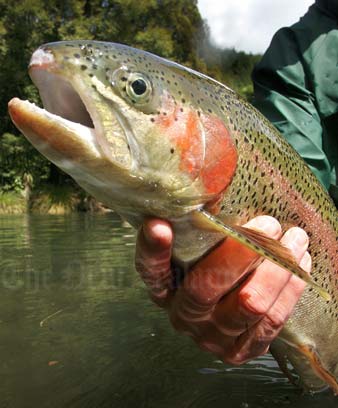Story summary
European settlers brought trout and salmon to New Zealand’s lakes and rivers so they could fish them for sport. The most common species today are brown trout, rainbow trout and Chinook salmon.
Brown trout
Brown trout were brought in during the 1860s and quickly spread into the rivers and lakes. With plenty of native fish to eat, the trout grew fat – weighing up to 10 kilograms. Today, most brown trout caught by fishermen weigh 1–2 kilograms.
- They prefer cooler water and live in rivers, lakes and estuaries south of the Coromandel Peninsula.
- They hide under rocks or streamside plants, and are difficult to catch.
- Their colours change with the habitat. Brown trout that swim out to sea are bright silver, those in lakes are dull silver, and those in rivers are golden brown. All have black spots.
- They usually live for eight to ten years.
Rainbow trout
Rainbow trout were imported in the 1880s. They did not spread and breed as well as brown trout. Today, anglers often catch rainbow trout weighing 2–3 kilograms.
- They live in lakes such as Lake Rotorua and Lake Taupō, and rivers flowing in and out of these lakes.
- They do not migrate to sea.
- They are easier to catch than brown trout.
- In winter, fishermen catch them in the Tongariro River, upstream from Lake Taupō.
- They usually live for four to five years.
Chinook salmon
Chinook or quinnat salmon are native to North America and Asia, and were brought to New Zealand in the early 1900s. They are big, often weighing 10–15 kilograms.
- They spawn (breed) in tributaries of rivers on the east coast of the South Island, such as the Waitaki, Rakaia and Rangitātā.
- New Zealand is the only place in the world where they have been successfully released outside their native home.
- Some salmon habitats have been harmed because river water is taken to irrigate farms, and rivers have been dammed. This reduces salmon numbers.
- Young salmon swim out to sea, then after three or four years return upstream to spawn.
- Unlike trout, they die after spawning.





